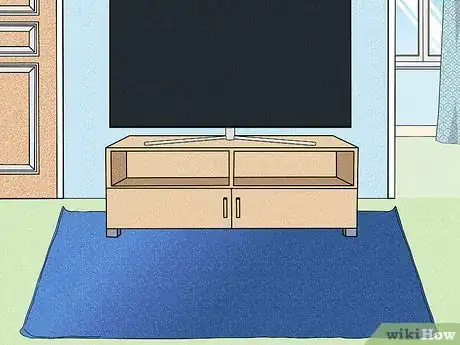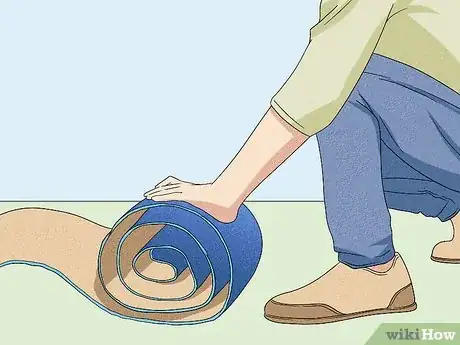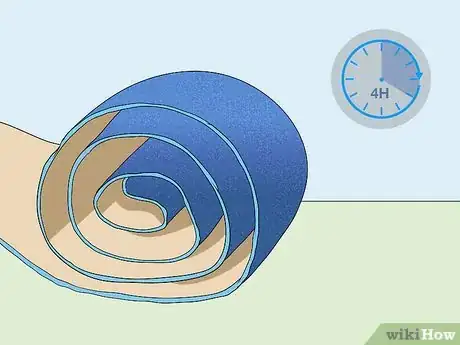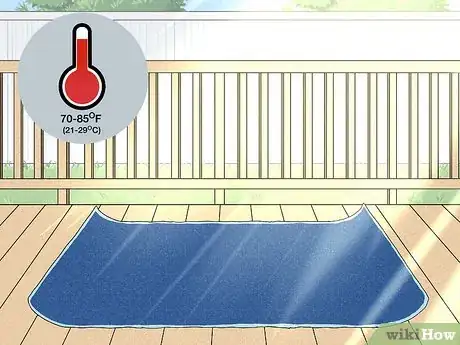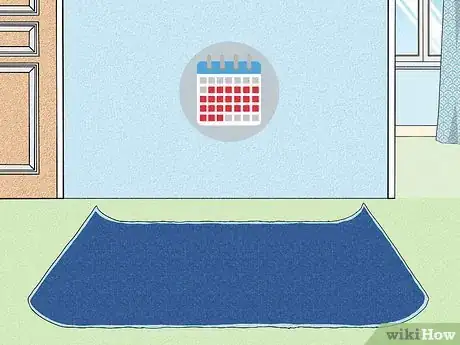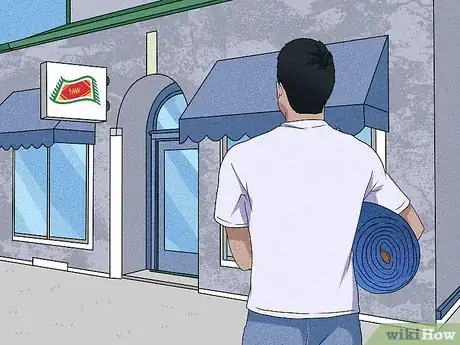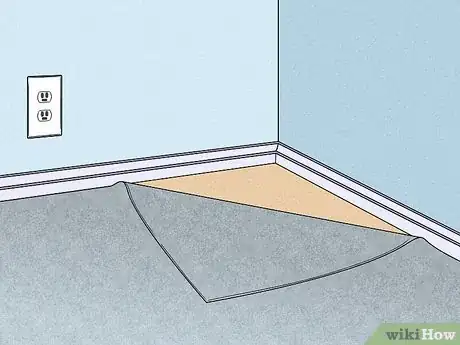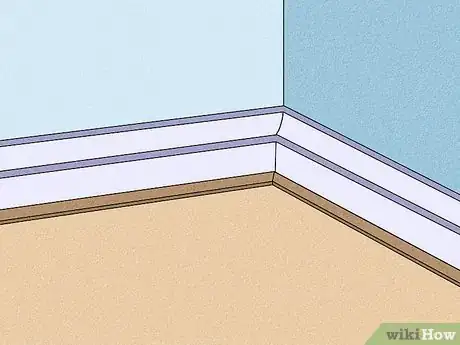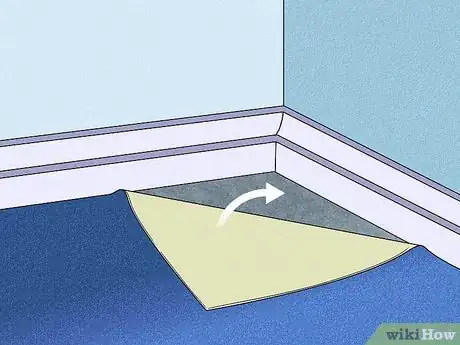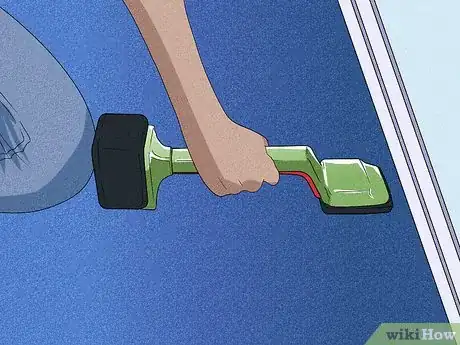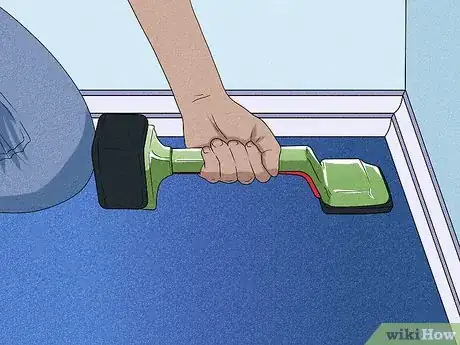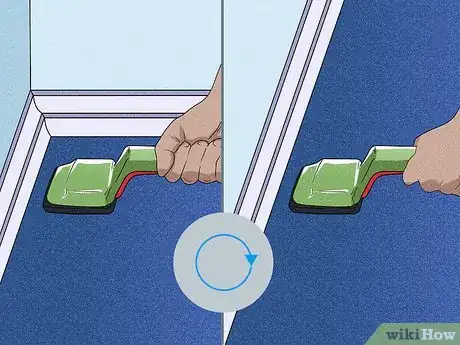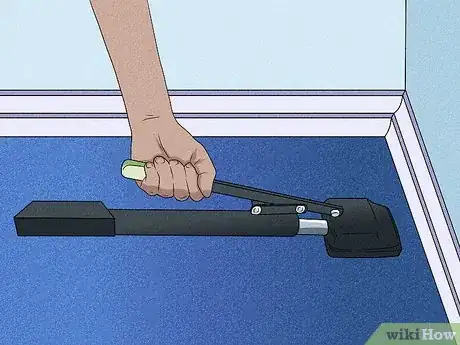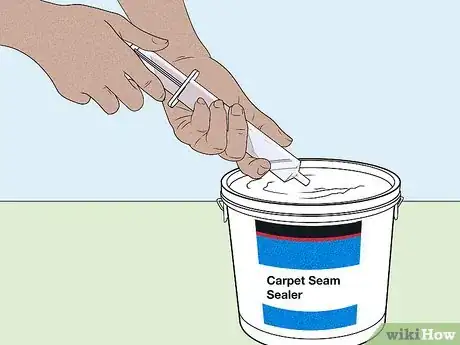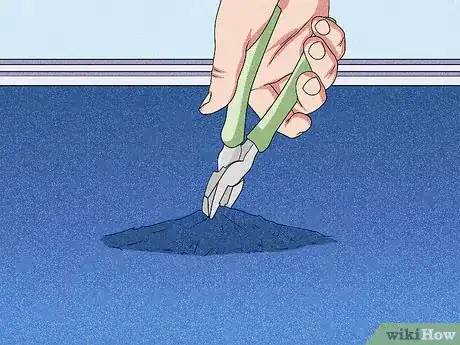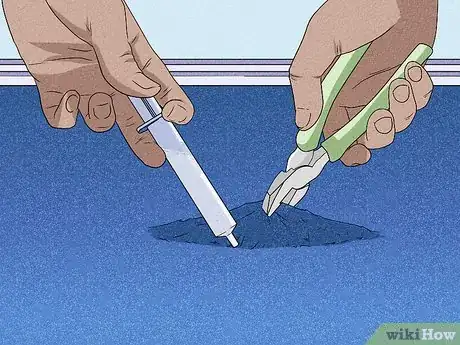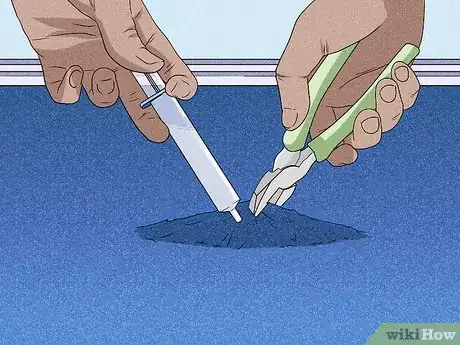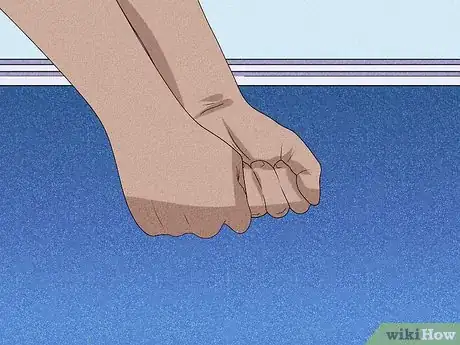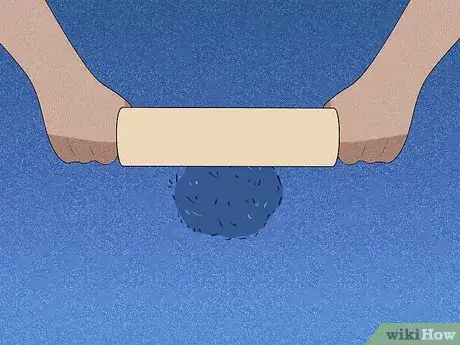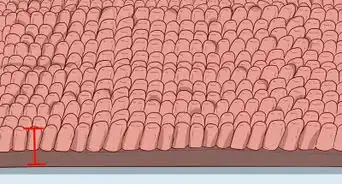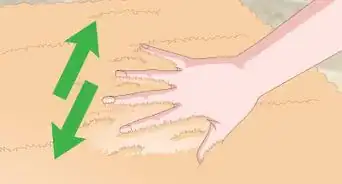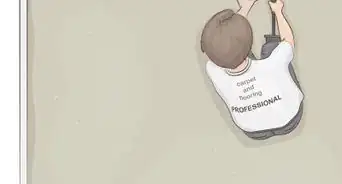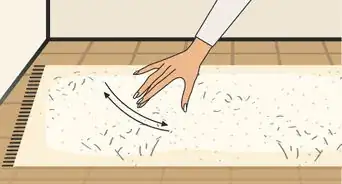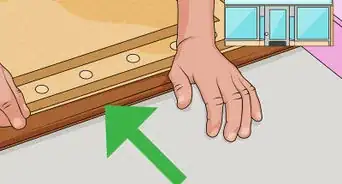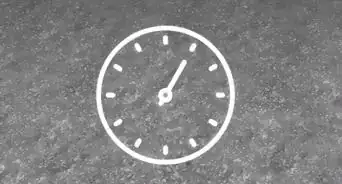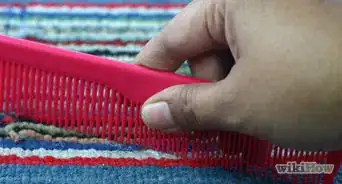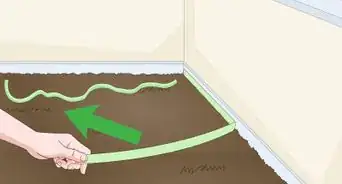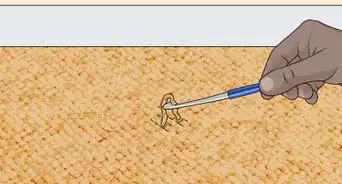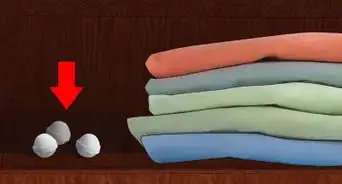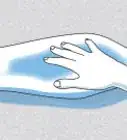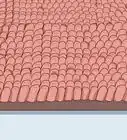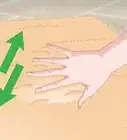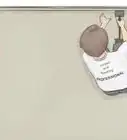This article was co-authored by Abraham Schwartz. Abraham Schwartz is a handyman and the owner of Fixin’ To Do, a home improvement service in Austin, Texas. Abraham specializes in both small to medium residential and commercial sized jobs, ranging from TV mounting to furniture assembly to home automation setup. Prior to starting Fixin’ To Do, Abraham worked for over 10 years as a handyman for third party services and had a lifetime of learning how to improve houses. He holds both his TSBPE Plumbing Examiners and Electrical Apprentice (TX) Licenses. In 2018 and 2019, Fixin’ To do was rated as a Top Pro by Thumbtack.
This article has been viewed 269,368 times.
Rolled up carpets can develop creases, curls, and folds that show up when the carpet is unrolled. A few simple tricks can reduce the tension that causes these when you first unroll it. Then, when it’s time to install, stretching the carpet out with a knee kicker should get rid of any remaining creases. Finally, if any lingering tension causes bumps to rise in your carpet once it’s installed, applying glue between that and the floor with a syringe will easily fix this.
Steps
Reducing Creases and Curls in Rolled Carpeting
-
1Weigh your carpet down. Set a piece of furniture or any other suitably heavy object(s) on both corners of one end of your carpet. Then pull the carpet taut by its free end to stretch it out. Inspect the area in between for creases and curls. Smooth them out by hand and place weights on them, as well. Pull the carpet taut again by its free end before weighing down both of its corners, too.[1]
- To make life easier, ask a partner for help. This way one person can keep the carpet pull and relax the carpet as needed while the other deals with creases and curls in the middle.
- For small carpets, you can probably just use a few strategically placed piles of heavy objects like books, potted plants, or actual weights.
- For larger carpets, use large furniture with a large surface area, like overturned coffee or end tables, to cover more area.
-
2Roll it up in the opposite fashion. This is known as “back-rolling” or “reverse-rolling.” Roll the carpet back up after it has sat in the sun for a few hours. Only this time, roll it so that the side that originally faced outward (usually the carpet’s underside) is now on the inside of your roll. As you do:[2]
- Work slowly. Keep an ear out for any cracking noises as you roll. If you hear any, quit right away. This indicates damage to the carpet’s skeleton.
- Don’t roll it as tight as before. Keep your reverse roll fairly loose. This will reduce the chance of cracking and the creation of new creases and curls. If you heard any cracks during your first attempt, try again with a much looser roll.
Advertisement -
3Leave it back-rolled for a few hours. Give the carpet some time for its tension to relax. Then lay it out again and see how well it worked. If needed, redo your reverse roll and repeat.[3]
-
4Unroll the carpet in direct sunlight. For the most exposure, unroll your carpet outside as long as it’s sunny and within 70 to 85 degrees Fahrenheit (21 to 29 degrees Celsius). If that isn’t possible, choose an area within your home that has adequate floor space and receives direct sunlight. Adjust your thermostat to keep the temperature between 70 and 85 degrees F. Let your carpet sit for at least four hours (or better yet, as long as daylight lasts).[4]
- The absorption of heat and light will help reduce the carpet’s tension, which will make further steps more effective.
-
5Just give it some time. If you're not in a particular rush for a perfect looking carpet, just lay it out as is for the time being. Give it a few days or even weeks to relax itself on its own. You can also try laying it upside down or alternating between the two positions.[5]
-
6Have the carpet professionally steamed. Bring the carpet into a local rug store that offers steaming services, rather than hire a cleaner to do the job at your house. Though there might be exceptions, expect at-home cleaners to only be familiar with how to clean a carpet. So bring it to a store that specializes in rugs instead, where the staff should be able to assess and treat the problem with your particular carpet.[6]
- For example, steaming should work just fine if the carpet was simply rolled up for an extended period. However, if the carpet won't lie flat for some other reason (like poor construction) that steaming won't fix, a rug specialist will be able to spot this and say so before you waste money on the service.
Stretching Out New Wall-to-Wall Carpeting
-
1Lay out your carpet’s padding first. If you’re installing wall-to-wall carpeting, clear the area of all furniture, plus the floor covering to be replaced (if you have any). Then cover the subfloor from wall to wall with carpet padding. Staple the padding to the subfloor to secure it in place.[7]
-
2Install tack strips. These are generally an inch (2.5 cm) wide, but may be as long as four feet (1.2 m), so saw or cut them to length as needed. Place each strip end-to-end on the floor, leaving about a half-inch (1.25 cm) of space between the strips and the wall. Nail them into place through the padding until you’ve lined all of the room’s edges.[8]
- For heavier carpets, you may wish to add a second row of tack strips. If you do, place these on the first row’s farthest side from the wall.
- Always leave a half-inch gap in between the wall and the nearest strip. You’ll need to keep this space clear in order to worm the carpet’s edges underneath the baseboards.
-
3Lay out your carpet. Unroll it over the carpet padding. If the carpet is one solid color, simply line up its corners with the room’s. If it’s patterned, double-check its orientation to make sure it’s lined up the way you want it. For instance:[9]
- Say you’re using the same carpeting in this room and the hallway outside. For a more seamless look, orient it the same way in both areas. So if the pattern incorporates, say, pine trees, arrange the carpet so the treetops all point in the same direction.
-
4Start “kicking” one edge into the place. Choose a wall to start working along. Once you do, start in the middle of that wall. Set the head of a knee kicker on the carpet, roughly four to five inches (10 to 13 cm) from the baseboard, at a 90 degree angle to the wall. Then:[10]
- Hold the kicker firmly in place by its handle with your dominant hand. Kneel on your opposite leg’s knee and support yourself with your other hand.
- Drive your dominant side’s knee into the base of the knee kicker to drive the carpet toward the wall. Repeat until the edge of the carpet slightly overlaps the baseboard.
- Press the carpet in that area into the tack strip below to secure it into place.
-
5Work toward that wall’s corners. Once you’ve secured the middle of your first edge to the floor, move a couple feet to either side. Set the knee kicker’s head on the carpet, about four to five inches from the wall. This time, however, set it so it’s at a 45 degree angle with the wall, with the base pointing toward the center of the room. Except for that one difference, drive and secure the rug into place in the same fashion as before.[11]
- Depending on the length of your wall, repeat every couple of feet until you reach the corner. Then switch to the other side from where you started and continue until you reach the other corner.
- Setting the kicker at a 45 degree angle to the wall as you work toward the corners will help stretch out any creases toward the center of the carpet.
-
6Repeat with each wall. Start with the opposite wall to keep the carpeting aligned with the others as you work. Secure its edge along that wall as you did with the first. Then do the same with the other walls. Check your carpeting for creases as you go along. If the knee kicker isn’t doing the job of stretching them out on its own:
- Detach the carpet from the tack strips so you can do it over with the extra aid of a lever-activated stretcher.[12]
-
7Use a lever-activated stretcher if needed. If you have to do the job over, repeat the knee-kicker steps along one wall. Only this time, don’t press the carpet down into the tack strip once you finish with that. Instead, use a lever-activated stretcher to pull the carpet even tauter toward the wall before securing it in place.
- The principle of a lever stretcher is the same. The only difference is in its operation. With these, you pump a lever up and down instead of using your knee.[13]
- These are also a good alternative if you have a very large project or prior knee injuries. The repeated force of impact when using a knee kicker extensively can lead to physical trauma.
Getting Rid of Bubbles in Installed Carpet
-
1Load a syringe with glue. First, purchase a container of carpet seam sealer large enough to address the amount of floor area in question. Additionally, pick up a food syringe. Remove the sealer’s cap and draw an adequate amount into your syringe.[14]
-
2Puncture the carpet. First, locate the bubble. Feel with your fingers to estimate its circumference. Once you have an idea of where its edges are, grip its center with a pair of pliers. Then puncture the center with the syringe’s needle.[15]
-
3Inject glue along the edges. Continue lifting the bubble up by its center with the pliers. As you do, angle the syringe’s needle toward the edge of the bubble. Push the needle farther in as needed in order to reach the edge. Then push down on the syringe’s plunger to line the subfloor with glue along the bubble’s edge. Rotate the syringe as you work in order to apply a circular line of glue.[16]
-
4Work your way inward. Continue applying glue in the same fashion. As you do, start drawing the needle out of the carpet. Create concentric circles of glue underneath the carpet spiraling in toward the center of the bubble.[17]
-
5Press into place. Once you have drawn the needle all the way out, set the syringe aside. Starting from the center of the bubble, use your hands to push the edge into the subfloor. Ensure the glue makes contact with the carpet’s underside while spreading it out at the same time for wider contact. From there, continue outward toward the bubble’s edges.[18]
-
6Reinforce contact while the glue dries. Use a rolling pin to smooth the carpet even further once you’ve finished pressing the bubble down into place with your hands. Then set weights over the area to keep the glue in contact with the carpet until it sets. Check the glue’s instructions regarding drying times. Leave the weights in place for at least that long.[19]
Expert Q&A
Did you know you can get expert answers for this article?
Unlock expert answers by supporting wikiHow
-
QuestionHow can I protect wall-to-wall carpeting?
 Abraham SchwartzAbraham Schwartz is a handyman and the owner of Fixin’ To Do, a home improvement service in Austin, Texas. Abraham specializes in both small to medium residential and commercial sized jobs, ranging from TV mounting to furniture assembly to home automation setup. Prior to starting Fixin’ To Do, Abraham worked for over 10 years as a handyman for third party services and had a lifetime of learning how to improve houses. He holds both his TSBPE Plumbing Examiners and Electrical Apprentice (TX) Licenses. In 2018 and 2019, Fixin’ To do was rated as a Top Pro by Thumbtack.
Abraham SchwartzAbraham Schwartz is a handyman and the owner of Fixin’ To Do, a home improvement service in Austin, Texas. Abraham specializes in both small to medium residential and commercial sized jobs, ranging from TV mounting to furniture assembly to home automation setup. Prior to starting Fixin’ To Do, Abraham worked for over 10 years as a handyman for third party services and had a lifetime of learning how to improve houses. He holds both his TSBPE Plumbing Examiners and Electrical Apprentice (TX) Licenses. In 2018 and 2019, Fixin’ To do was rated as a Top Pro by Thumbtack.
Handyman
-
QuestionHow can I get my rug to fluff back up after flattening it?
 Abraham SchwartzAbraham Schwartz is a handyman and the owner of Fixin’ To Do, a home improvement service in Austin, Texas. Abraham specializes in both small to medium residential and commercial sized jobs, ranging from TV mounting to furniture assembly to home automation setup. Prior to starting Fixin’ To Do, Abraham worked for over 10 years as a handyman for third party services and had a lifetime of learning how to improve houses. He holds both his TSBPE Plumbing Examiners and Electrical Apprentice (TX) Licenses. In 2018 and 2019, Fixin’ To do was rated as a Top Pro by Thumbtack.
Abraham SchwartzAbraham Schwartz is a handyman and the owner of Fixin’ To Do, a home improvement service in Austin, Texas. Abraham specializes in both small to medium residential and commercial sized jobs, ranging from TV mounting to furniture assembly to home automation setup. Prior to starting Fixin’ To Do, Abraham worked for over 10 years as a handyman for third party services and had a lifetime of learning how to improve houses. He holds both his TSBPE Plumbing Examiners and Electrical Apprentice (TX) Licenses. In 2018 and 2019, Fixin’ To do was rated as a Top Pro by Thumbtack.
Handyman
Things You’ll Need
Reducing Creases and Curls
- Sunlight
- Warm weather or adjustable thermostat
- Furniture or other heavy objects
Stretching Out Wall-to-Wall Carpeting
- Carpet padding
- Tack strips
- Nails
- Hammer or nail gun
- Knee kicker
- Lever-activated stretcher (optional)
Getting Rid of Bumps
- Carpet seam sealer
- Food syringe
- Pliers
References
- ↑ http://www.rugrag.com/post/Will-These-Creases-Ever-Come-out.aspx
- ↑ http://www.rugrag.com/post/Will-These-Creases-Ever-Come-out.aspx
- ↑ http://www.rugrag.com/post/Will-These-Creases-Ever-Come-out.aspx
- ↑ http://www.rugrag.com/post/Will-These-Creases-Ever-Come-out.aspx
- ↑ http://www.rugrag.com/post/Will-These-Creases-Ever-Come-out.aspx
- ↑ http://www.rugrag.com/post/Will-These-Creases-Ever-Come-out.aspx
- ↑ https://www.thisoldhouse.com/how-to/how-to-install-carpeting
- ↑ https://www.thisoldhouse.com/how-to/how-to-install-carpeting
- ↑ https://www.thisoldhouse.com/how-to/how-to-install-carpeting
- ↑ https://www.youtube.com/watch?v=Drn4zSY-QLg
- ↑ https://www.youtube.com/watch?v=Drn4zSY-QLg
- ↑ https://www.thisoldhouse.com/how-to/how-to-install-carpeting
- ↑ https://www.cdc.gov/niosh/docs/90-104/
- ↑ http://extremehowto.com/repair-a-carpet-bubble/
- ↑ http://extremehowto.com/repair-a-carpet-bubble/
- ↑ http://extremehowto.com/repair-a-carpet-bubble/
- ↑ http://extremehowto.com/repair-a-carpet-bubble/
- ↑ http://extremehowto.com/repair-a-carpet-bubble/
- ↑ http://extremehowto.com/repair-a-carpet-bubble/
